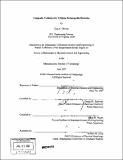| dc.contributor.advisor | Donald R. Sadoway and Anne M. Mayes. | en_US |
| dc.contributor.author | Olivetti, Elsa A | en_US |
| dc.contributor.other | Massachusetts Institute of Technology. Dept. of Materials Science and Engineering. | en_US |
| dc.date.accessioned | 2008-11-10T19:54:45Z | |
| dc.date.available | 2008-11-10T19:54:45Z | |
| dc.date.copyright | 2007 | en_US |
| dc.date.issued | 2007 | en_US |
| dc.identifier.uri | http://dspace.mit.edu/handle/1721.1/39554 | en_US |
| dc.identifier.uri | http://hdl.handle.net/1721.1/39554 | |
| dc.description | Thesis (Ph. D.)--Massachusetts Institute of Technology, Dept. of Materials Science and Engineering, 2007. | en_US |
| dc.description | Includes bibliographical references. | en_US |
| dc.description.abstract | The utility of incorporating continuous, nanoscale vanadium oxide phases within preferred domains of self-organizing copolymers was investigated towards the fabrication of composite, nanoarchitectured electrode materials for solid-state rechargeable batteries. In situ growth of cathodic phases within ion-conducting copolymer domains was explored as a means to control morphology and to increase the surface-area-to-volume ratio, thereby increasing the specific electrode area for faradaic reactions and decreasing ion diffusion distances within the electrode-active material. Copolymers of microphase-separating rubbery block and graft copolymers, previously developed as solid electrolytes, provide a matrix for directing the synthesis of an inorganic battery-active phase. The copolymers include poly[(oxyethylene)9 methacrylate]-block-poly(butyl methacrylate) (POEM-b-PBMA) with a domain periodicity of -35 nm made by atom transfer radical polymerization, and poly[(oxyethylene)9 methacrylate]-graft-poly(dimethyl siloxane) (POEM-g-PDMS) with a domain periodicity of-17 nm made by free radical polymerization. The resulting microphase-separated polymer is a structure of alternating hydrophilic (Li-ion conducting) and hydrophobic regions. | en_US |
| dc.description.abstract | (cont.) Sol-gel chemistry involving a vanadium alkoxide precursor enabled the in situ growth of cathode-active vanadium oxide within the continuous ion-conducting POEM domains of the microphase-separated copolymers. Resulting films, termed POEM-b-PBMA/VOx and POEM-g-PDMS/VOx, were freestanding and mechanically flexible. Small angle x-ray scattering and transmission electron microscopy revealed the nanoscale morphology of the composite and confirmed the spatially-selective incorporation of up to 34 wt% VO, in POEM-b-PBMA and 31 wt% in POEM-g-PDMS. Electronically conductive components, necessary for wiring of the lithium-active vanadium oxide domains to the external circuit, were added through a variety of methods. Dispersions of acid-treated and cryo-ground carbon black within POEM-b-PBMA/VOx enabled the cycling of this material as a cathode. Reversible capacities of-~ 40 mAh/g were measured for batteries fitted with a polymer electrolyte doped with LiCF3SO3 and a lithium foil anode. Electrolyte thickness studies indicated battery performance was limited by the ionic conductivity of the solid electrolyte. | en_US |
| dc.description.abstract | (cont.) Using liquid electrolyte resulted in improved capacity (at higher currents) over conventional composite cathodes made from sol-gel derived vanadium oxide without the polymer matrix. The vanadium oxide nanoarchitecture was preserved upon removal of the polymer by heat treatment. The resulting templated vanadium oxide, when repotted with carbon black and binder, exhibited improved capacity at high current over non-templated vanadium oxide cathodes. | en_US |
| dc.description.statementofresponsibility | by Elsa A. Olivetti. | en_US |
| dc.format.extent | 155 p. | en_US |
| dc.language.iso | eng | en_US |
| dc.publisher | Massachusetts Institute of Technology | en_US |
| dc.rights | M.I.T. theses are protected by
copyright. They may be viewed from this source for any purpose, but
reproduction or distribution in any format is prohibited without written
permission. See provided URL for inquiries about permission. | en_US |
| dc.rights.uri | http://dspace.mit.edu/handle/1721.1/39554 | en_US |
| dc.rights.uri | http://dspace.mit.edu/handle/1721.1/7582 | en_US |
| dc.subject | Materials Science and Engineering. | en_US |
| dc.title | Composite cathodes for lithium rechargeable batteries | en_US |
| dc.type | Thesis | en_US |
| dc.description.degree | Ph.D. | en_US |
| dc.contributor.department | Massachusetts Institute of Technology. Department of Materials Science and Engineering | |
| dc.identifier.oclc | 174145347 | en_US |
